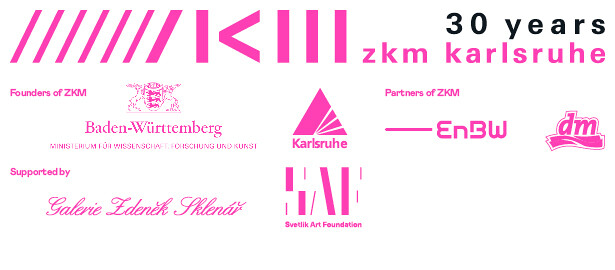October 13, 2019–March 8, 2020
Lorenzstr. 19
76135 Karlsruhe
Germany
Hours: Wednesday–Friday 10am–6pm,
Saturday–Sunday 11am–6pm
T +49 721 81001200
info@zkm.de
In his work, the Czech-German artist Michael Bielicky (born in 1954) creates idiosyncratic hybrids that belong simultaneously to both a digital and an analogue world. Technological innovation enters into dialogue with the depths of media history, reaching all the way back to the magical mathematical practices of medieval Kabbalists. Experiences with the avant-garde film and media culture of the 1960s in Prague, where Bielicky grew up, converge with Jewish spirituality in the artist’s reflections on media.
Bielicky’s work deals with the transformation of media technology and its societal, philosophical and political implications; he facilitates critical engagement with the nature of technology, with its material and immaterial meanings, and with their influence on our perceptions and actions. The artist’s studies in the 1980s at the Düsseldorf art academy, where the influence of the Fluxus movement lingered and Nam June Paik and Joseph Beuys were key figures, had a formative influence on his critical and at times ironic stance toward our media present. Along with the influence of his mentor, Nam June Paik, Bielicky’s encounters and lifelong friendships with other media philosophers and artists such as Vilém Flusser, Peter Weibel, Woody Vasulka, Mel Alexenberg, Peter Sloterdijk, Siegfried Zielinski and Norman M. Klein have played a seminal role in his artistic work.
Michael Bielicky has been working together with the artist Kamila B. Richter (born in 1976) since 2004. The duo coined the term “data-driven narratives” to describe the multi-dimensional works of Internet art that they develop, which deal with the new, non-linear narrative principles of the digital information age. Using dynamic pictograms and integrating real-time data, they create large-format projections that powerfully and experientially treat the ubiquity of data and icons in our algorithmically driven everyday lives. The works provoke both attraction and unease, prompting us to question our own existence in the context of our present-day media ecology.
With early photographs from the 1980s, video works from the 1980s and 1990s, pivotal video sculptures, four large net-based installations, an outdoor installation and some recent works, the exhibition offers a multi-faceted overview of a body of work that the artist, who teaches at the Karlsruhe University of Arts and Design, has created over the course of more than forty years. The exhibition also features documentary material from Michael Bielicky’s extensive media archive, which has been worked through and digitized since 2016 in cooperation with the ZKM. The holdings will now become part of the ZKM | Archive, which already includes extensive holdings from artists and theorists.
Michael Bielicky’s works have been shown internationally at numerous exhibitions and festivals, including the São Paulo Biennale (1987), the Videonale (1988, 1990, 1992), the Multimediale 2 (1991), Montevideo, Amsterdam (1991), Ars Electronica (1992, 1994, 1995), the International Biennial of Contemporary Art of Seville (2008), the Moscow Biennale (2011), Global Contemporary at the ZKM | Karlsruhe (2011), the Havana Biennial (2012), and GLOBALE at the ZKM (2015). An exhibition of his works created in collaboration with Kamila B. Richter took place at the Centro de Arte Contemporáneo Wifredo Lam in Havana, Cuba, in 2017. Works by Michael Bielicky have recently been shown at the ZKM in the exhibitions Open Codes (2017–2019) and DIA-LOGOS. Ramon Llull and the ars combinatoria (2018).
In conjunction with the exhibition, an artist’s book of approximately 300 pages will be published by edition cantz at the beginning of 2020, featuring six essays by authors including Mel Alexenberg, Peter Sloterdijk, Peter Weibel, and Siegfried Zielinski, as well as numerous illustrations of art works and documentation material from Michael Bielicky’s archive.
Curator: Bettina Korintenberg
Research Assistance: Paul Kenig
Display: Andreas Arndt, Olaf Quantius
Graphic design: Sascha Fronczek


